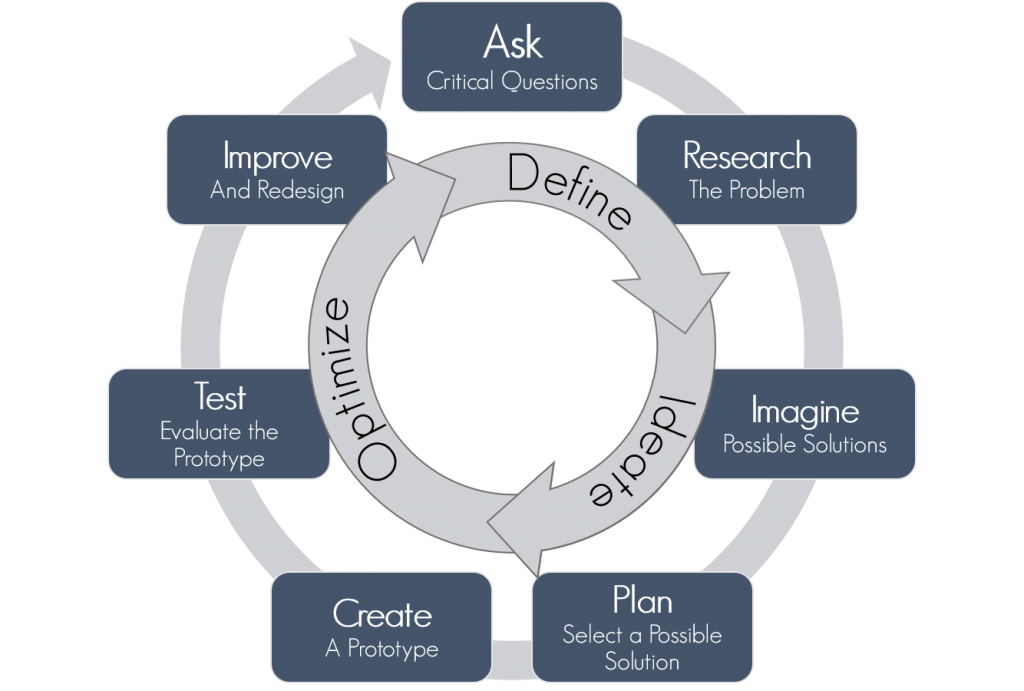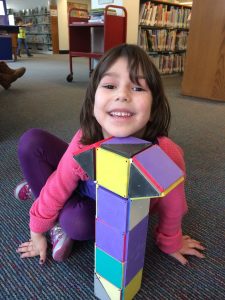By Casey Rawson
A child is frustrated because he can’t get the last bit of toothpaste out of the tube. A teenager tries to fit all of their friends into a selfie, but can’t hold the phone quite far enough away. Parents watch their children play at the park, but don’t sit down, because the bench is still covered in last night’s rain. A woman at a coffeeshop has to place her purse on the table because there is nowhere to hang it on the rounded chair backs.
Individually, these might all be considered minor annoyances. But they are also all problems that might be solved with some innovative thinking—the type of thinking that engineers are trained to engage in every day. From small innovations like notches on coffeeshop chair backs to complex designs that make human space flight possible, engineering is all around us. And while required math, science, and technical expertise night put advanced engineering tasks out of reach for those without specialized training, the processes and practices used by engineers are accessible to even the youngest learners. They are also perfect targets for library instruction.
In this chapter, we will discuss engineering from a design process perspective. We will share information about how engineering is taught in public schools and to whom, before examining how and why it might be taught in the public library setting.
What is Engineering?
Among all of the STEAM domains, engineering may be the most practical. Engineering can be broadly defined as the application of science, math, technology, and design to solve real world problems. The National Research Council distinguished engineering from science by stating that science is focused on asking questions and constructing explanations, while engineering is focused on defining problems and designing solutions (Committee on a Conceptual Framework for New K-12 Science Education Standards, 2012). Even more than in the other STEAM domains, engineering education is focused on process and practices versus memorizable concepts. Specifically, this discipline is concerned with the process of engineering design: an iterative approach to problem solving that involves defining a problem space, imagining multiple possible solutions, then testing and refining those solutions over multiple cycles. This process is summarized in the diagram below, adapted from the Engineering Design Process model created by TeachEngineering (https://www.teachengineering.org/).
Although distinct from the other STEAM domains in some ways, the National Academy of Engineering emphasized that engineering relies on science, math, and technology to support design activities (Katehi, Pearson, & Feder, 2009). We would argue that the arts are just as critical to effective engineering design, since many engineered products are developed as much for form as for function (for more on this, see the next chapter).
Engineering in the Traditional Classroom
While the other STEAM domains have longer histories in formal K-12 education, engineering is a relatively recent addition to public schools, and many students still receive little or no formal education related to engineering (Miaoulis, 2016; von Zastrow & Kelly, 2019). In 2001, Massachusetts became the first state in the U.S. to introduce engineering into the public school curriculum, in large part due to the efforts of Dr. Ioannis Miaoulis, then Dean of the Tufts University School of Engineering and an early advocate for the creation of a K-12 engineering curriculum (Miaoulis, 2016; Williams, McCulloch, McMahon, & Goodyear, 2016). Massachusetts later served as one of the leaders of the Next Generation Science Standards (NGSS) initiative, and that state’s existing engineering standards became a model for the NGSS engineering content (Williams, McCulloch, McMahon, & Goodyear, 2016).
The NGSS positions “Engineering, Technology, and the Applications of Science” as one of the four central scientific disciplines, alongside physical sciences, life sciences, and Earth and Space sciences. Engineering design standards are included in the NGSS at all grade levels. For example, NGSS standard K-2-ETS1-1 states that students in grades K-2 should be able to “ask questions, make observations, and gather information about a situation people want to change to define a simple problem that can be solved through the development of a new or improved object or tool” (Next Generation Science Standards, 2013). The NGSS presents science and engineering concepts and practices with a spiral approach, meaning that students will encounter the same ideas at multiple points in their K-12 education with increasing levels of complexity. Thus, the main idea of the K-2 standard above (defining a problem) returns throughout the NGSS framework, until by high school it has evolved in complexity: “analyze a major global challenge to specify qualitative and quantitative criteria and constraints for solutions that account for societal needs and wants” (HS-ETS1-1).
Many arguments have been made for the continued expansion of engineering education in K-12 public education. The National Academy of Engineering’s Committee on K-12 Engineering Education argued that “ K–12 engineering education may improve student learning and achievement in science and mathematics; increase awareness of engineering and the work of engineers; boost youth interest in pursuing engineering as a career; and increase the technological literacy of all students,” and “may even act as a catalyst for a more interconnected and effective K–12 STEM education system in the United States” (Katehi, Pearson, & Feder, 2009, p. 1). In addition, K-12 engineering education is commonly proposed as a way to improve the diversity of the engineering workforce. As of 2017, only 16% of engineers were female, and only 11% were underrepresented minorities (Black, Hispanic, or American Indian or Alaska Native) (National Science Board, 2020).
Unfortunately, current data about the prevalence of engineering education in K-12 schools indicates that some of the same inequities seen within the engineering workforce are also present in K-12 schools. A 2019 report from the Education Commission of the States found that although students in general are increasingly likely to report exposure to engineering instruction, students of color and students from low-income households are less likely than their white, wealthier peers to have had an engineering course, and are less likely to have access to trained teachers, materials, and equipment (von Zastrow & Kelley, 2019). This report also found that girls of color were the least likely of all students to have taken an engineering course, which points to the need for an intersectional analysis of equity in engineering education. Although 20 states have adopted the NGSS, and another 24 have adopted other standards based on the same framework (von Zastrow & Kelley, 2019), this data suggests that engineering education is still far from universal in public schools.
Engineering Beyond School
As discussed in earlier chapters, afterschool programs, clubs, and camps are another common site for STEM- and STEAM-based education. A recent national survey by the Afterschool Alliance (2016) found that approximately seven out of ten parents reported that their children were exposed to STEM learning in their afterschool program. However, this study also found that “math and science programming far exceed the availability of technology and engineering programs offered in afterschool” (p. 14). Access to these opportunities is also not uniform; rural areas, in particular, were less likely to offer STEM- or STEAM-based afterschool programming (Afterschool Alliance, 2016).
Clubs and camps are another option for out-of-school engineering education, however these opportunities are also unequal, particularly when it comes to income. National data show a strong correlation between family income and the likelihood of participation in extracurricular clubs or lessons for children and teens (Knop & Siebens, 2018). Data also suggests that this participation gap may be widening over time with increasing income and wealth inequality in the U.S. (Wong, 2015). Thus, as in other STEAM domains, there is a need for increased access to engineering education that is not currently being met by existing out-of-school providers. This is where the public library can come in.
Engineering Instruction and the Library “Curriculum”
The engineering design process shares much in common with both information literacy process models and existing library standards and competencies frameworks. Like engineering, we typically present the information literacy process as an iterative one, and many information literacy models include steps similar to some of those in the engineering design process model shared above. For example, “Ask critical questions” and “Research possible solutions” are analogous to the question formulation and information seeking steps of the academic research process. The YALSA Teens First learning outcomes include several benchmarks that align perfectly with the engineering design process, including:
- Think flexibly
- Innovate
- Demonstrate an openness to risk-taking
- Experiment, prototype and test ideas
- Demonstrate curiosity (Young Adult Library Services Association, 2017).
One major advantage that the library and other informal or nonformal education environments have over formal education spaces in terms of engineering education is that because we do not give students tests or grades, it is safer for learners to fail in our spaces. Failure may not seem like a desirable outcome, but in fact it is critical to the engineering design process (TeachEngineering, n.d.). Part of engineering is generating many possible solutions to a problem, some of which may unexpectedly fail, while others unexpectedly overperform. We can’t know which designs will work until we test them. Even when a design does initially work as anticipated, engineers often intentionally stress the prototype until it fails, to determine its limitations. Such stress tests are critical during the design process to avoid failures once the solution has been implemented—failures that could cost lives, as in high profile engineering disasters such as the 1986 Challenger space shuttle explosion or the more recent failure of the “angle-of-attack” sensor in the Boeing 737 Max aircraft, which caused two planes to crash, killing more than 300 people.
The How of Teaching Engineering in a Library Setting
Perhaps because it aligns so neatly with existing public library standards and values, engineering-focused programming is already fairly common in public libraries. These offerings include both small-scale “one-shot” programs such as a “LEGO One Scoop Challenge” (Volner, 2016) to much more involved ongoing program series, such as the STEMgineering Academy offered at Hempstead (NY) Public Library (Abbondandolo, 2019). Design challenges are a particularly popular, simple, and effective way of incorporating engineering education into the public library setting. As the name suggests, this type of activity involves presenting a predetermined design task to learners and providing them with a variety of materials they can use to fulfill the task. The callout box below provides links to several collections of design challenge prompts.
Design Challenge Resources
- Engineering design activities from TeachEngineering: http://bit.ly/2SJpYdU
- Design challenges from Technovation Families: https://www.curiositymachine.org/challenges/
- Engineering design activities from Try Engineering: https://tryengineering.org/teachers/lesson-plans/
- Engineering design challenges for libraries from STARnet: http://bit.ly/2SGhu71
Engineering is also a great candidate for passive instructional programming. For example, simple building materials such as magnetic tiles, LEGOs, or Kinex might be placed in the children’s or teens’ area, alongside signage suggesting possible design prompts (such as “Can you build a tower that is taller than this line?” or “Can you build something that rolls?”). This type of design prompt could also be integrated into your library’s makerspace, if you have one.
Keeping in mind the fact that engineering education focuses on the processes and practices of engineers even more than specific content allows us to think about how engineering principles might be integrated into library programs or interactions that, on their surface, may seem to have little to do with STEAM. For example, consider a teen advisory board group that has identified a problem in your library; perhaps they have noticed that the teen programming area is too exposed, and teens don’t feel comfortable talking about sensitive topics there. While this is not inherently a STEAM issue, it is a great candidate for application of the engineering design process. Your teens have identified a problem: now, how might they solve it? You can even encourage individual children and teens to use elements of the engineering design process in more casual, spontaneous interactions. For example, imagine that you are trying to help an elementary-age visitor who wants to find Star Wars books with pictures. Some of these books are located in the graphic novel collection, while others are located in the juvenile fiction area, and all are organized by their author’s last name, meaning that they are not all together or easily browsable. Noticing the visitor’s frustration with this, you might ask them: what are some of your ideas for how these books should be organized in the library? You and the visitor have identified a problem, and can verbally brainstorm possible solutions (which you might later test).
As we plan engineering-focused instruction, it is important that we keep equity in mind. The public library can play an important role in improving access to engineering fields for women and underrepresented minorities not only through the provision of original programming, but also by exposing children and teens to female and nonbinary, Black, indigenous, and/or Latinx engineers. This can be accomplished via the resources you choose to purchase, promote, and use in your library, and by inviting engineers from underrepresented backgrounds to your space to interact with children and teens. Consider reaching out to or partnering with organizations that support women and people of color in engineering. These include:
- Society of Women Engineers (https://swe.org/),
- IEEE Women in Engineering (https://www.ieee.org/membership/women-in-engineering.html),
- National Society of Black Engineers (http://nsbe.org/home.aspx),
- American Indian Science and Engineering Society (https://www.aises.org/)
- Latinos in Engineering and Science (http://mymaes.org/)
- Society of Hispanic Professional Engineers (https://shpe.org/)
- National Action Council for Minorities in Engineering (https://www.nacme.org/about-us)
These organizations, or others like them, may be excited about partnering with the public library to develop connections between practicing engineers from underrepresented groups and young people who may never have seen an example of an engineer who looks like them.
 Spotlight: STEM Lab On-the-Go at Hartford Public Library
Spotlight: STEM Lab On-the-Go at Hartford Public Library
The Hartford (CT) Public Library system’s STEM Lab On-the-Go program is a great example of how community partnerships can lead to innovative and high quality engineering programming in the public library. This program provides semi-monthly training workshops for youth librarians focused on STEM programming, led by a STEM Specialist from Manchester Public Schools, as well as a centralized set of STEM-based program plans and materials that are shared among the system’s eight branches. The STEM program models are collaboratively developed by librarians and educators, including a team at the Connecticut Science Center, and are available free online at https://www.hplct.org/library-services/kids/stem-kits.
The engineering kit includes detailed plans for nine engineering-focused library programs, designed for a wide range of age levels and spanning the disciplines of electrical, software, and mechanical engineering. The instructor’s guide includes a crosswalk that connects each lesson to NGSS standards, and the activities have been designed to integrate multiple STEAM domains while still focusing on engineering. For example, one program designed for tweens integrates engineering and physical science:
Students will build their own small-scale model roller coasters using pipe insulation and marbles, and then analyze them like engineers do. They will learn the connection between kinetic and potential energy and frictional effects to design roller coasters that are completely driven by gravity. A class competition will be held using different marbles types to represent different passenger loads determines the most innovative and successful roller coasters. (Curtin, n.d., p. 3).
STEM Lab On-the-Go was funded by the Voya Foundation (Hartford Public Library, 2019).
Conclusion
The world will always need people who can identify problems and find workable solutions, whether or not those people are professional engineers. This recognition has led to the gradual, but as yet incomplete and unequal, incorporation of engineering education in the public school curriculum Teaching children and teens to use the engineering design process might help them obtain an engineering job one day, or it might simply help them approach their own personal challenges more systematically and with more tolerance for ambiguity and failure, but either way, it is difficult to argue that this type of education is not valuable. Libraries can help bridge gaps in the quality and quantity of engineering education that children and teens receive, especially when we focus on the processes and practices of engineering rather than its more technical aspects.
References
Abbondandolo, J. (2019). STEMgineering academy. YALSA Teen Programming HQ. Retrieved from http://hq.yalsa.net/programs/6176/stemgineering-academy
Afterschool Alliance (2016). Full STEM ahead: Afterschool programs step up as key partners in STEM education. Washington, D.C. Retrieved from http://www.afterschoolalliance.org/AA3PM/STEM.pdf
Committee on a Conceptual Framework for New K-12 Science Education Standards (2012). A framework for K-12 science education: Practices, crosscutting concepts, and core ideas. Washington, D.C.: National Academies Press. Retrieved from https://www.nap.edu/read/13165/chapter/1
Curtin, C. (n.d.). Teacher’s handbook: Engineering science kit. Hartford Public Library. Retrieved from https://www.hplct.org/assets/uploads/files/Library%20Services/Youth/Engineering%20Science%20Kit.pdf
Hartford Public Library (2019, February 19). Voya Financial funds Hartford Public Library’s
STEM Lab On-the-Go for second year. Retrieved from https://www.hplct.org/assets/uploads/files/Hartford%20Public%20Library_Voya%20STEM%20Grant%20Release_2_19_2019.pdf
Katehi, L., Pearson, G., & Feder, M. (Eds.) (2009). Engineering in K-12 education: Understanding the status and improving the prospects [executive summary]. National Academy of Sciences, Committee on K-12 Engineering Education. Retrieved from https://www.nsf.gov/attachments/117803/public/1b–Eng_in_K-12_Ed.pdf
Knop, B., & Siebens, J. (2018). A child’s day: Parental interaction, school engagement, and extracurricular activities: 2014. U.S. Census Bureau, Current Population Reports. Retrieved from https://www.census.gov/content/dam/Census/library/publications/2018/demo/P70-159.pdf
Maoulis, I. N. (2016). Engineering an education revolution. PE Magazine. Retrieved from https://www.nspe.org/resources/pe-magazine/january-2016/engineering-education-revolution
National Science Board (2020). 2020 science and engineering indicators: The state of U.S. science and engineering 2020. Retrieved from https://ncses.nsf.gov/pubs/nsb20201
Next Generation Science Standards (2013). Retrieved from https://www.nextgenscience.org/search-standards
TeachEngineering (n.d.). Engineering design process. Retrieved from https://www.teachengineering.org/k12engineering/designprocess
Volner, A. (2016). The LEGO one-scoop challenge. YALSA Teen Programming HQ. Retrieved from http://hq.yalsa.net/programs/724/the-lego-onescoop-challenge
Williams, D., McCulloch, C., McMahon, T., & Goodyear, L. (2016). Engineering for every K–12 student: A landscape analysis of K–12 engineering education in the greater Boston region. Boston: Tufts University and EDC. Retrieved from https://ceeo.tufts.edu/documents/researchMEIDCreport.pdf
Wong, A. (2015, January 30). The activity gap. The Atlantic. Retrieved from https://www.theatlantic.com/education/archive/2015/01/the-activity-gap/384961/
Young Adult Library Services Association (2017). Teens first: Basic learning outcomes. Retrieved from http://www.ala.org/yalsa/sites/ala.org.yalsa/files/content/Teens%20First_%20Basic%20Learning%20Outcomes%20Guide.pdf

